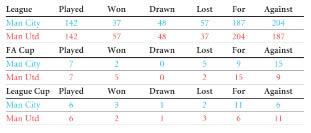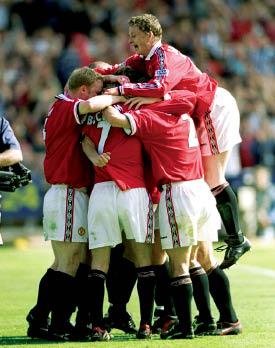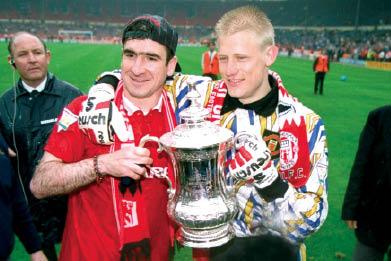Little Book of Manchester United (6 page)
Read Little Book of Manchester United Online
Authors: Ian Welch
Tags: #Sports & Recreation, #Football

*The blue and red halves of Manchester are separated by stewards and police.
Although the two sides have met in various rounds of the FA Cup and League Cup, the only showpiece match they have contested was the 1956 FA Charity Shield where League Champions United ran out 1-0 winners against FA Cup holders City thanks to a Dennis Viollet strike. The match was played at Maine Road because the Old Trafford floodlights were not yet operational for this mid-week encounter.

*Figures correct to end 2008-09 season.
Docherty
Before his move to Manchester United in December 1972, Tommy Docherty was a player with Preston and Arsenal, a Scottish international and the manager of Scotland.
Known as ‘The Doc’, he brought new players to Old Trafford and avoided relegation but this proved to be short-lived, because in April 1974 United were relegated to the Second Division for the first time since 1937. They were Second Division Champions in 1975 and Docherty took his team to the 1976 FA Cup Final where they were beaten by Southampton. Undeterred, United fought back under Docherty’s leadership and beat Liverpool 2-1 the following season to claim the trophy.

*Tommy Docherty, the Manchester United manager from 1972 to 1977.
This was to be Docherty’s last match in charge as, when his affair with the club physiotherapist’s wife was revealed on 3 June 1977, he lost his job. He continued his career and went on to manage Chelsea, QPR three times, Aston Villa, Rotherham, FC Porto, Derby County, Preston and Wolverhampton Wanderers, ending his career with a short spell in Australia and as manager of non-League Altrincham.
Double
Considering only three teams had previously managed to complete the Double of League title and FA Cup in the 20th century (Tottenham Hotspur in 1961, Arsenal in 1971 and Liverpool in 1986), the fact that Manchester United achieved this feat twice in three seasons underlines their dominance of the domestic game in the 1990s.

*United players celebrate victory after the FA Cup Final match against Newcastle United where they completed the Double for the third time in six years, May 1999.
Following the capture of their first League title for more than a quarter of a century, United went into the 1993-94 season on a high. By the end of March, they had lost just two League games – both home and away to Chelsea – and would finish the season by suffering just two more defeats to finish with a then-record Premiership points tally of 92. The FA Cup Final saw a 4-0 demolition of Chelsea with Cantona netting two penalties. Sadly, Sir Matt Busby passed away on 20 January so would never see his beloved United register their first Double.

* Cantona and Schmeichel hold the trophy after their FA Cup Final victory against Chelsea at Wembley in 1994. United won the match 4-0 completing their first double.
United claimed their second Double in 1995-96, this time losing six games en route to the Premiership title although they remained unbeaten at Old Trafford. Chelsea were the victims in the semi-final this year and it fell to Cantona to score the only goal of the FA Cup Final against Liverpool.
C
HAPTER 5:
E
-
E
DWARDS,
E
UROPEAN
C
UP,
E
UROPEAN
C
UP
W
INNERS’
C
UP,
E
UROPEAN
F
OOTBALLER OF THE
Y
EAR
Edwards
Born 1 October 1936, Duncan Edwards became the youngest ever player in the First Division at the age of just 16. He made his international debut aged 18 for England in the 7-2 victory over Scotland in April 1955, becoming the youngest international player of the 20th century. It is argued that Edwards was the best United player of all time.
By the time of his death, aged 21, in the Munich tragedy, he had earned the nickname ‘manboy’ because he helped United to win the Youth Cup in the same month that he made his international debut. He won three Youth Cups, two League titles and an FA Cup Finalist’s medal.

*The legendary Duncan Edwards in January 1958.
What made Edwards stand out initially was his size. At 15 he had looked like a giant and played like a man in the opinion of Matt Busby. But he combined awesome power with a lighter touch, he could kill the ball dead and dribble as well as unleashing an accurate 50-yard pass. Edwards was unassuming and liked by his teammates who just accepted that he could achieve more physically than they could. As left-back, he usually wore the number six shirt, but he was gifted enough to play virtually anywhere on the pitch.
The Busby Babes were a talented bunch, but Edwards was a natural. For 15 days after the Munich crash, he defied chronic kidney damage, a collapsed lung, a broken pelvis and ribs as well as a smashed right thigh before his death on 21 February 1958. Sir Bobby Charlton had the ultimate praise for his former teammate: “The best player I’ve ever seen, the best footballer I’ve ever played with for United or England, and the only player who ever made me feel inferior.”
European Cup
United’s first outing in the European Cup took place on 12 September 1956 when they beat Anderlecht 2-0 away. In the return leg at Maine Road, the home side registered their record European victory with a 10-0 rout. Their run would take them to the semi-final where they lost to holders Real Madrid.
The 1957-58 season saw United again qualify to compete against Europe’s elite. This was made more poignant, however, by the Munich air disaster which had occurred as the team were returning home from their victorious quarter-final second leg clash against Red Star Belgrade. The team that beat AC Milan 2-1 in the home leg but lost 4-0 in the San Siro contained just four of the players (Gregg, Foulkes, Morgans and Viollet) whose efforts had got United this far.

*Action in the Real Madrid goalmouth as United attack.
It would take until 1965-66 for United to again qualify. They got to the semi-final once more, having defeated the mighty Benfica 8-3 on aggregate in the quarter-final with George Best outshining the newly-crowned European Footballer of the Year Eusebio. But United went out at the hands of Partizan Belgrade.
Their next attempt to claim Europe’s top club prize would be successful, however, as Hibernian Malta, Sarajevo and Gornik Zabrze were despatched en route to a semi-final showdown with Real Madrid. Taking a slender 1-0 lead to the Bernabeu, United battled out a 3-3 draw to earn themselves a place in the Final against Benfica. Bobby Charlton (apart from Foulkes, the only Munich survivor in the side) opened the scoring in the second half before Jaime Graca equalised for the Portuguese. Extra time saw three goals from George Best, 19-year-old birthday boy Brian Kidd and a second for Charlton bring the trophy back to England for the first time.
The attempt to retain the trophy began well with a 10-2 aggregate mauling of Irish side Waterford and victories against Anderlecht and Rapid Vienna but AC Milan prevailed.
European Cup Winners’ Cup